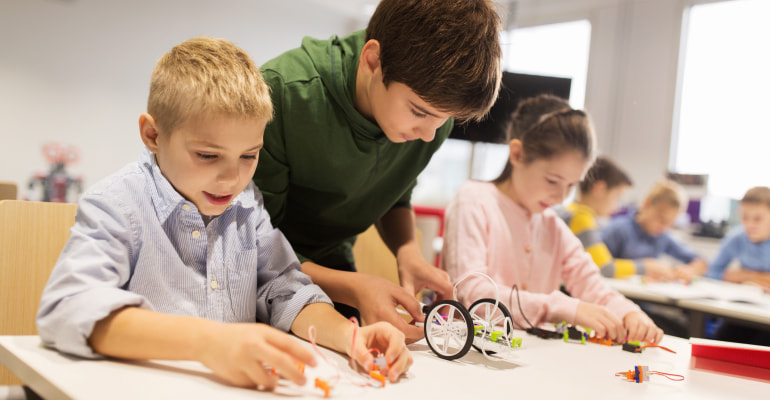How to Introduce STEM Engineering Concepts to Your Elementary Classroom

Engineering applies to nearly everything we do, but how do you introduce such a vast and versatile concept to elementary school students? And which engineering concepts should elementary students be practicing?
As an organization dedicated to equitable access to STEM education, we’ve created this guide for educators on how to introduce the basics of engineering to your elementary classroom and build a solid foundation for this core STEM subject.
What is engineering?
Helping students define what engineering is (and isn’t) is just as important as incorporating engineering activities and lesson plans. When students understand its definition, they can recognize the various applications of engineering in the world around them.
So what is engineering? Engineering is the use of math and science to solve real-world problems.
It’s the combination of math and science with creative problem-solving that make up the essence of engineering. It includes building structures, designing products, improving machinery, and much more.
Engineering has a place in nearly every scientific field as the practical application that stems from the information and laws that science and mathematics provide.
How to define engineering for elementary students

For elementary students, it’s important to introduce them to these two elements of engineering:
1. Engineering = creating something new.When you engineer something, you are building. This includes building a skyscraper out of building blocks or building a computer code to control a robot. If you create a new way to organize your schoolbooks, you’ve just engineered a new organizational system!
The more examples you can provide to your elementary students, the better. It’s helpful to introduce them to the many applications of engineering through the simplicity of building or creating new things. This helps students recognize the vast array of engineering all around them and builds their confidence in STEM. When engineering is simply creating something new, they can see that they’re already engineers themselves!
2. Engineering uses science and math as tools.Science and math give engineering the tools, structure, and information that are needed to build new things. Science brings exploration, experimentation, and proven discoveries through the use of the scientific method. Mathematics holds the numerical laws we rely on to measure and plan for the things we engineer.
For example, if you want to build (or engineer) a new dog house for Fido, you might use science to help you experiment with the best shape for the roof to keep Fido dry or the best materials to use to withstand the weather the dog house will be exposed to. Then, you would use mathematics to calculate the dimensions of the dog house so that Fido fits and how much you need in materials. Using science and math to inform your design, you’ve just engineered a new dog house!
Elementary Classroom Activity: Defining Engineering
In a class discussion or worksheet, choose 4-6 different engineering applications and have students contribute ideas of how science and math are used in each application.
Example: Creating a new garden design for the school.
- How science is used:
- Choosing building materials (what kinds of materials will last outdoors and work well for planter boxes and plants?)
- Analyzing the weather to choose the best time to build and plant
- Choosing where to plant plants based on the sunlight and water resources they need
- How math is used:
- Planning how many building materials you need
- Measuring and planning out how the space of the garden will be used (pathway, planter boxes)
- Measuring the distances between plants to account for their future growth
Introduce as many different types of engineering as possible to help students understand its many applications.

Engineering Subjects for an Elementary School Curriculum
There are so many ways to use engineering, so how do you choose which subjects to introduce to students? As passionate builders of science-backed STEM curricula from Pre-K through elementary and middle school, these are our suggestions for the core engineering topics to introduce to your elementary students for a solid foundation in engineering and STEM.
1. The Engineering Process
Once students have an understanding of what engineering is, it’s time to introduce the engineering process! The engineering process gives students a helpful framework to approach STEM challenges.
At Kid Spark, this process is introduced in our STEM Pathways Lab for elementary students Grades 2-5. (Get a preview of the curriculum here!)
The five-step Kid Spark Design & Engineering Process includes:
- Identifying the challenge
- Brainstorming ideas & solutions
- Building a prototype
- Testing and improving the design
- Explaining the design
Through these five steps, students become acquainted with the methodological approach that empowers them to approach new challenges with curiosity, creativity, and logic. Thinking strategically about challenges is a skill that can help throughout their educational career, and early practice explaining their own designs further develops their comprehension of the design and engineering skills employed in their creation.
Through fun, hands-on lesson plans and STEM activities, students can explore the engineering process and the exciting engineering concepts to follow!
2. Structural Engineering
As early as Pre-K, we believe in introducing young learners to the basic concepts of engineering. This often includes introductory building exercises. By the elementary level, students can explore more applications of structural engineering to understand:
- How to make engineered building designs stronger
- How length and height affect stability
- How to apply ratios to engineered designs
- And much more
The varied structural engineering lesson plans in the Kid Spark curriculum are designed for both students and educators. With our lab kits, you can use the same reusable engineering components for numerous lesson plans and design challenges throughout the school year.
Build and explore beams, structures, bridges, and frames through dynamic building blocks and exercises. With an elementary understanding of how things are constructed, elementary students are then ready to explore how things move and function with mechanical engineering.

3. Mechanical Engineering
In a broad sense, mechanical engineering touches on nearly every scientific field, designing, developing, building, and testing products, systems, and machinery.
For elementary students, mechanical engineering includes the investigation of motion and physics. How do simple and complex machines work? How can you increase efficiency, speed, load, or torque through engineering principles?
If these concepts seem mature for the elementary classroom, rest assured that young learners are quick to grasp these STEM concepts when the right curriculum is in place. Students of all ages desire to be challenged just enough while learning new ideas. We call this space the learning edge: the comfort zone in which new concepts are challenging enough to keep us engaged and not so simple where things are boring and easy.
To achieve the learning edge while introducing mechanical engineering concepts to elementary students, we believe in a cumulative approach to STEM education as a whole.
First, students are introduced to mechanisms and motions such as rotary motion. They are given ample time to learn, practice, and experiment with this topic through hands-on lesson plans and creative design challenges. Then, a new concept, like, linear motion, is introduced: starting with the foundation of simple rotary motion to move an object linearly.
As new concepts are introduced, they build upon previous engineering concepts so that students gain cumulative knowledge and experience with each engineering subject.
To try this in your class, try breaking down larger mechanical engineering concepts or machines into their smaller components. Gradually add each component so that students gain familiarity with each topic and stay within their learning edge!
4. Robotics
Robotics uses electrical, mechanical, and computer engineering–and elementary students are ready to explore each of these through creative lesson plans and activities!
Robots in the elementary classroom provide a fun, interactive, and exciting outlet to apply students’ practiced engineering concepts. With the immediate cause-and-effect students experience while programming and building robots, they can quickly navigate the engineering process and experiment with speed.
Worried about accessing quality educational robotic programs? Consider leaning into your STEM ecosystem by partnering with another school, library, museum, or other educational institution to provide access to your students. As passionate pursuers of equitable STEM education, Kid Spark also provides grants for our STEM Lab Kits, or you can explore other ways to find funding through afterschool programs, STEM enrichment programs, or additional outside funding.

Explore Kid Spark’s Elementary STEM & Engineering Curriculum for Your Classroom
At Kid Spark Education, we know that empowering students in STEM comes from empowered educators. That’s why our labs are designed with both students and teachers in mind.
If you’re looking for a comprehensive curriculum to bring engineering into your elementary classroom, Kid Spark lab kits include a science-backed curriculum that meets NGSS requirements, reusable engineering and robotic tools, complete lesson plans and design challenges to practice many STEM concepts, and educator tools such as online training, grading rubrics, and step-by-step instructions for teachers.
Establishing the basics of engineering in elementary can build students’ confidence to approach the world with curiosity and creativity. To talk with a curriculum specialist, contact Kid Spark today!
.png?width=1270&height=453&name=Copy%20of%20Kid%20Spark%20Logo%20(Horizontal%20-%20Full%20Color).png)